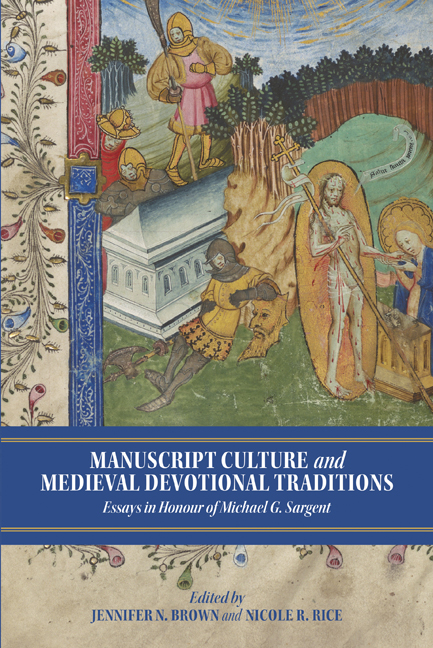Book contents
- Frontmatter
- Dedication
- Contntes
- List of Illustrations
- Acknowledgements
- List of Abbreviations
- Michael Sargent: An Appreciation
- I Manuscript Transmission and Textual Adaptation
- II Translated Texts and Devotional Implications
- III Rhetorical Strategies and Spiritual Transformations
- IV Texts and Contours of Religious Life
- Bibliography
- List of Contributors
- Michael G. Sargent’s Publications
- Index
- Tabula Gratulatoria
- York Manuscript and Early Print Studies
11 - Beauty in Liturgy: The Carmelites and the Resurrection
Published online by Cambridge University Press: 24 March 2021
- Frontmatter
- Dedication
- Contntes
- List of Illustrations
- Acknowledgements
- List of Abbreviations
- Michael Sargent: An Appreciation
- I Manuscript Transmission and Textual Adaptation
- II Translated Texts and Devotional Implications
- III Rhetorical Strategies and Spiritual Transformations
- IV Texts and Contours of Religious Life
- Bibliography
- List of Contributors
- Michael G. Sargent’s Publications
- Index
- Tabula Gratulatoria
- York Manuscript and Early Print Studies
Summary
Carmelites are perhaps best known for their charism of prayer and contemplation. In the popular imagination, members of the order conduct enclosed, secluded lives best exemplified by Teresa of Avila (1515–82) and her nuns. Although Teresa and her companions lived in an environment of liturgy and devotion, the emphasis she brought to the religious life was on the interior life and not the external, liturgical forms of prayer. However, the distinction between interior and exterior is to an extent an artificial one, useful perhaps for the purposes of analysis. The honouree of this volume is a fine example of a scholar who appreciates the devotional culture in which contemplative texts are produced and the important connection between context and content.
The Carmelite order, originating in Palestine in the early thirteenth century and present in Europe from the middle of that century, was one of two mendicant orders in the Middle Ages that had its own ‘rite’, or way of celebrating the Mass and Office. The other order was the Dominicans, and their liturgical history has been well investigated and documented. By contrast, the history of the Carmelite rite has been produced only relatively recently. In some ways this is surprising, given that Carmelite writings on prayer and contemplation were elaborated in that atmosphere and context of liturgical devotions. One of the reasons for the relative neglect of this area of Carmelite life may be that in 1972 the General Council of the Carmelite order decided to put the rite into abeyance. The reason given at the time was that congregations were unfamiliar with this form of the Mass. The promulgation of ‘Summorum Pontificum’ by Pope Benedict XVI in 2007 and the explanatory Instruction ‘Universae Ecclesiae’ in 2011 opened the way for the use by religious orders of their own rites where they existed. Inevitably this gave rise to some reflection on the value of these forms which were proper to some religious orders. In the Carmelite order, while there was no real move to restore the ancient liturgy, there was, however, some interest in re-examining the inspiration and theological dimensions of that rite.
- Type
- Chapter
- Information
- Manuscript Culture and Medieval Devotional TraditionsEssays in Honour of Michael G. Sargent, pp. 243 - 258Publisher: Boydell & BrewerPrint publication year: 2021



